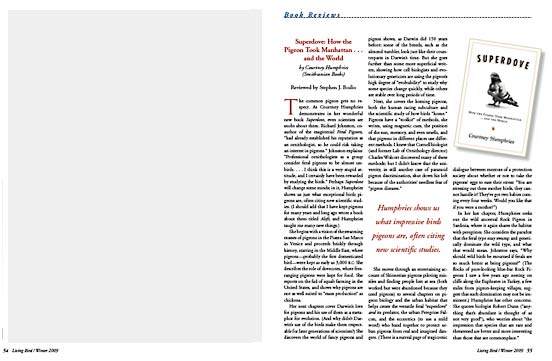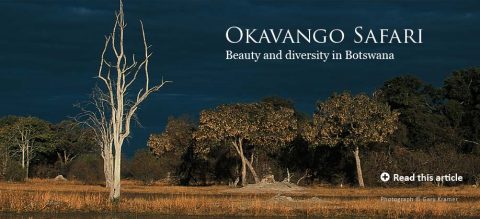Book Review: Superdove: How the Pigeon Took Manhattan…and the World
Reviewed by Stephen J. Bodio January 15, 2009
The common pigeon gets no respect. As Courtney Humphries demonstrates in her wonderful new bookSuperdove, even scientists are snobs about them. Richard Johnston, co-author of the magisterial Feral Pigeons, “had already established his reputation as an ornithologist, so he could risk taking an interest in pigeons.” Johnston explains: “Professional ornithologists as a group consider feral pigeons to be almost un-birds. . . . I think this is a very stupid attitude, and I certainly have been rewarded by studying the birds.” Perhaps Superdove will change some minds; in it, Humphries shows us just what exceptional birds pigeons are, often citing new scientific studies. (I should add that I have kept pigeons for many years and long ago wrote a book about them titledAloft, and Humphries taught me many new things.)
She begins with a vision of the swarming masses of pigeons in the Piazza San Marco in Venice and proceeds briskly through history, starting in the Middle East, where pigeons—probably the first domesticated bird—were kept as early as 3,000 B.C. She describes the role of dovecotes, where free-ranging pigeons were kept for food. She reports on the fad of squab farming in the United States, and shows why pigeons are not as well suited to “mass production” as chickens.
Her next chapters cover Darwin’s love for pigeons and his use of them as a metaphor for evolution. (And why didn’t Darwin’s use of the birds make them respectable for later generations of scientists?) She discovers the world of fancy pigeons and pigeon shows, as Darwin did 150 years before; some of the breeds, such as the almond tumbler, look just like their counterparts in Darwin’s time. But she goes further than some more superficial writers, showing how cell biologists and evolutionary geneticists are using the pigeon’s high degree of “evolvability” to study why some species change quickly, while others are stable over long periods of time.
Next, she covers the homing pigeons, both the human racing subculture and the scientific study of how birds “home.” Pigeons have a “toolkit” of methods, she writes, using magnetic cues, the position of the sun, memory, and even smells, and that pigeons in different places use different methods. I knew that Cornell biologist (and former Lab of Ornithology director) Charles Wolcott discovered many of these methods; but I didn’t know that the university, in still another case of paranoid pigeon discrimination, shut down his loft because of the authorities’ needless fear of “pigeon diseases.”
She moves through an entertaining account of Skinnerian pigeons piloting missiles and finding people lost at sea (both worked but were abandoned because they used pigeons) to several chapters on pigeon biology and the urban habitat that helps create the versatile feral “superdove” and its predator, the urban Peregrine Falcon, and the eccentrics (to use a mild word) who band together to protect urban pigeons from real and imagined dangers. (There is a surreal page of tragicomic dialogue between mentors of a protection society about whether or not to take the pigeons’ eggs to ease their stress: “You are stressing out these mother birds, they cannot handle it! They’ve got two babies coming every four weeks. Would you like that if you were a mother?”)
In her last chapter, Humphries seeks out the wild ancestral Rock Pigeon in Sardinia, where it again shares the habitat with peregrines. She considers the paradox that the feral type may swamp and genetically dominate the wild type, and what that would mean. Johnston says, “Why should wild birds be mourned if ferals are so much better at being pigeons?” (The flocks of pure-looking blue-bar Rock Pigeons I saw a few years ago nesting on cliffs along the Euphrates in Turkey, a few miles from pigeon-keeping villages, suggest that such domination may not be imminent.) Humphries has other concerns. She quotes biologist Robert Dunn (“anything that’s abundant is thought of as not very good”), who worries about “the impression that species that are rare and threatened are better and more interesting than those that are commonplace.”
Humphries makes the case that pigeons are esthetically and scientifically fascinating. They deserve respect as a species at once familiar and strange, ecologically and “socially” unique. That may not be enough for some. She thought Johnston had proved they were worthy of study. But then she talked to another scientist. “I remarked that few scientists seemed interested in studying feral pigeons. ‘No, and it’s not a good idea,’ he said. ‘Because they’re not representative of anything. They’re a unique case in nature.’

All About Birds
is a free resource
Available for everyone,
funded by donors like you
American Kestrel by Blair Dudeck / Macaulay Library



